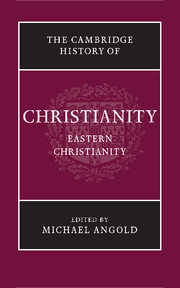Book contents
- Frontmatter
- PART I THE ECUMENICAL PATRIARCHATE
- PART II THE RUSSIAN CHURCH
- PART III EASTERN CHRISTIANITIES
- 16 Eastern Christianities (eleventh to fourteenth century): Copts, Melkites, Nestorians and Jacobites
- 17 The Armenians in the era of the crusades 1050–1350
- 18 Church and diaspora: the case of the Armenians
- 19 Church and nation: the Ethiopian Orthodox Täwahedo Church (from the thirteenth to the twentieth century)
- 20 Coptic Christianity in modern Egypt
- 21 Syriac Christianity in the modern Middle East
- PART IV THE MODERN WORLD
- Bibliography
- Index
- References
16 - Eastern Christianities (eleventh to fourteenth century): Copts, Melkites, Nestorians and Jacobites
from PART III - EASTERN CHRISTIANITIES
Published online by Cambridge University Press: 28 March 2008
- Frontmatter
- PART I THE ECUMENICAL PATRIARCHATE
- PART II THE RUSSIAN CHURCH
- PART III EASTERN CHRISTIANITIES
- 16 Eastern Christianities (eleventh to fourteenth century): Copts, Melkites, Nestorians and Jacobites
- 17 The Armenians in the era of the crusades 1050–1350
- 18 Church and diaspora: the case of the Armenians
- 19 Church and nation: the Ethiopian Orthodox Täwahedo Church (from the thirteenth to the twentieth century)
- 20 Coptic Christianity in modern Egypt
- 21 Syriac Christianity in the modern Middle East
- PART IV THE MODERN WORLD
- Bibliography
- Index
- References
Summary
The Coptic, Melkite, Nestorian and Jacobite communities possessed distinctive features, which set them apart from the other Orthodox churches studied in this volume. The first – and not the least important – was their establishment in countries which were under Muslim – and not Christian – rule. This was in complete contrast to the situation existing in the Byzantine Empire and in the kingdoms of Armenia and Georgia to the north, or in Nubia and Ethiopia to the south. A consequence of this was their juridically inferior status, known in Arabic as dhimma. This guaranteed members of the community rights of protection for themselves and their property, but in other ways discriminated against them. Their place in society cannot, however, just be reduced to a matter of juridical status, since there were marked variations according to time, place, social setting and reigning dynasty. In the first centuries of Islam Christianity, originally the dominant faith in most of the lands conquered by the Arabs, remained a majority faith, but by the eleventh century this was no longer so. Its progressive decline produced a new cultural outlook characterised by a reaffirmation of identity, which might require, depending on circumstance, accommodation with Islam or alliance with foreign powers.
Another distinctive feature of these Christian communities was their heterogeneity, which stemmed from the fact that there was no good reason for any Muslim power to impose on them one ecclesiastical obedience rather than another. It was not uncommon for several communities to congregate in the same place, which tended to be a source of conflict and weakness rather than strength.
- Type
- Chapter
- Information
- The Cambridge History of Christianity , pp. 371 - 403Publisher: Cambridge University PressPrint publication year: 2006
References
- 4
- Cited by

